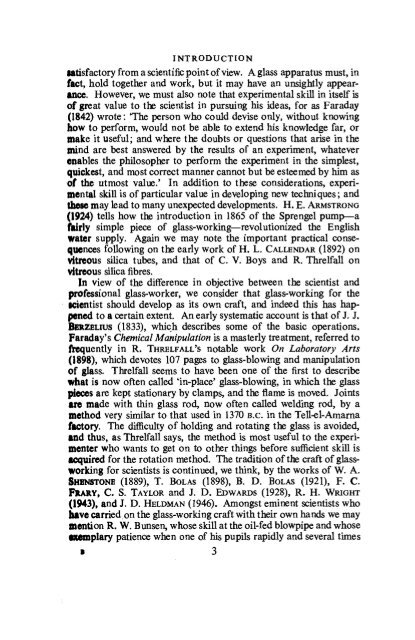Laboratory Glass-Working for Scientists - Sciencemadness Dot Org
Laboratory Glass-Working for Scientists - Sciencemadness Dot Org
Laboratory Glass-Working for Scientists - Sciencemadness Dot Org
Create successful ePaper yourself
Turn your PDF publications into a flip-book with our unique Google optimized e-Paper software.
M-N -<br />
INTRODUCTION<br />
satisfactory from a scientific point of view. A glass apparatus must, in<br />
fact, hold together and work, but it may have an unsightly appearance.<br />
However, we must also note that experimental skill in itself is<br />
of great value to the scientist in pursuing his ideas, <strong>for</strong> as Faraday<br />
(1842) wrote: The person who could devise only, without knowing<br />
how to per<strong>for</strong>m, would not be able to extend his knowledge far, or<br />
make it useful; and where the doubts or questions that arise in the<br />
mind are best answered by the results of an experiment, whatever<br />
enables the philosopher to per<strong>for</strong>m the experiment in the simplest,<br />
quickest, and most correct manner cannot but be esteemed by him as<br />
of the utmost value.' In addition to these considerations, experimental<br />
skill is of particular value in developing new techniques; and<br />
may lead to many unexpected developments. H. E. ARMSTRONG<br />
(1924) tells how the introduction in 1865 of the Sprengel pum;<br />
fairly simple piece of glass-working—revolutionized the English<br />
water supply. Again we may note the important practical consequences<br />
following on the early work of H. L. CALLENDAR (1892) on<br />
Vitreous silica tubes, and that of C. V. Boys and R. Threlfall on<br />
vitreous silica fibres.<br />
In view of the difference in objective between the scientist and<br />
professional glass-worker, we consider that glass-working <strong>for</strong> the<br />
icientist should develop as its own craft, and indeed this has happened<br />
to a certain extent. An early systematic account is that of J. J.<br />
BERZELIUS (1833), which describes some of the basic operations.<br />
Faraday's Chemical Manipulation is a masterly treatment, referred to<br />
frequently in R. THRELFALL'S notable work On <strong>Laboratory</strong> Arts<br />
(1898), which devotes 107 pages to glass-blowing and manipulation<br />
of glass. Threlfall seems to have been one of the first to describe<br />
what is now often called 1n-place' glass-blowing, in which the glass<br />
pieces are kept stationary by clamps, and the flame is moved. Joints<br />
are made with thin glass rod, now often called welding rod, by a<br />
method very similar to that used in 1370 B.C. in the Tell-el~Amarna<br />
factory. The difficulty of holding and rotating the glass is avoided,<br />
and thus, as Threlfali says, the method is most useful to the experimenter<br />
who wants to get on to otter things be<strong>for</strong>e sufficient skill is<br />
acquired <strong>for</strong> the rotation method. The tradition of the craft of glassworking<br />
<strong>for</strong> scientists is continued, we think, by the works of W. A.<br />
SHBNSTONB (1889), T. BOLAS (1898), B. D. BOLAS (1921), F. C.<br />
FlUltY, C. S, TAYLOR and J. D. EDWARDS (1928), R. H. WRIGHT<br />
(1943), and J. D. HELDMAN (1946). Amongst eminent scientists who<br />
have carried on the glass-working craft with their own hands we may<br />
mention R. W. Bunsen, whose skill at the oil-fed blowpipe and whose<br />
plary patience when one of his pupils rapidly and several times<br />
3
















